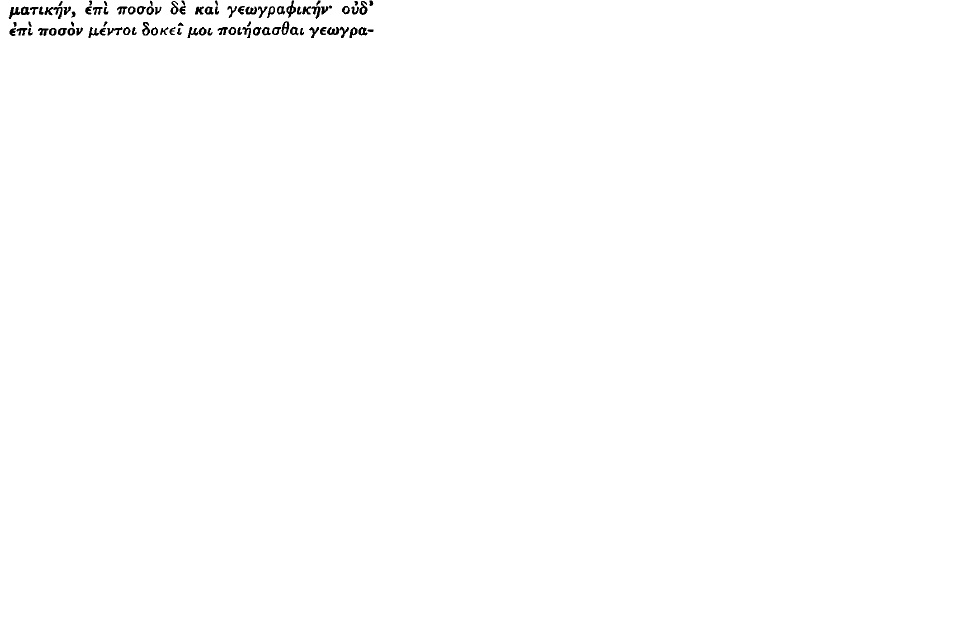Published online by Cambridge University Press: 11 February 2009
In a recent paper I discussed the origin of the concept of the climata in Greek geography, and adduced reasons for attributing the formulation and elaboration of the concept to Hipparchus (fl. 150 B.C.). The above passage in Strabo was naturally mentioned in the course of the argument, and I drew attention in a footnote to the unsatisfactory nature of the account given by him of the climata. I now propose to examine the passage in more detail
page 243 note 1 C.Q. xlix, pp. 248–55.Google Scholar
page 243 note 2 Ibid. n. 2, p. 252.
page 243 note 3 Str. 11 (i. 1.20) ff.: cf. 13.
page 243 note 4 Str. 12 (especially i. 1. 21).
page 243 note 5 Str. 13 (i. 1. 22)—this subservience to practical ends is typical of the new spirit introduced by the Romans into scientific inquiry, and is very different from the disinterested searching after truth of the earlier Hellenistic savants such as Hipparchus.
page 243 note 6 Str. 14 (i. 2. 1).
page 243 note 7 Str. 68–90 passim.
page 244 note 1 In addition to his purely astronomical works he wrote treatises entitled On Chords in a Circle, On Parallax, On Objects carried down by their Weight, On the Length of the Tear, and On Intercalary Months and Days. There are also hints of works on algebra, on the theory of numbers, and on optics.
page 244 note 2 

 Str. 94; cf. 92–93.
Str. 94; cf. 92–93.
page 244 note 3 This line was roughly the equivalent for ancient geographers of our ‘meridian of Greenwich’, and was taken as passing through Meroe, Alexandria, Rhodes, and the mouth of the Borysthenes (modern Dnieper); cf. Str. 62 (i. 4. 1). It formed the basic meridian for Eratosthenes' map. How it corresponded with the true meridian of Alexandria may be seen from the map on p. 164 of Thomson's, History of Ancient Geography, 1948.Google Scholar
page 244 note 4 Berger, E. H., Die geographischen Fragment des Hipparch, 1869.Google Scholar
page 244 note 5 Op. cit., pp. 29–30.Google Scholar
page 244 note 6 Op. cit., pp. 73 ff.Google Scholar
page 244 note 7 Cf. Str. 68–69; 71.
page 245 note 1 Cf. Thomson, , op. cit., pp. 205–7.Google Scholar
page 245 note 2 Geminus, Isag. v. 58; xvi. 17 (ed. Mani-this); Heidel, , The Frame of the Ancient Greek Maps, 1937, p. 125;Google Scholar cf. C.Q. xlix, p. 252.Google Scholar
page 245 note 3 See my paper 'Ancient Astronomical Instruments', Journal of the British Astronomi cal Association, vol. 64, Jan. 1954.Google Scholar
page 245 note 4 This progresses at first in steps of ½ hour (producing a gradually decreasing difference in the actual degrees of latitude from over 4° at first to just 1° at the end), then ½ hour, and finally whole hours.
page 245 note 5 Of course, beyond 66½—the arctic circle in the modern sense—the concept of rising times breaks down and only a few theoretical data would have been given; but there is no reason why Hipparchus, as Strabo says, should not have continued his table up to the north pole, for Ptolemy continues his list of latitudes in Almag. ii. 6 up to this point 'as a matter of theoretical interest' 
 .
.
page 246 note 1 Geogr. 8. 2. 2–3.
page 246 note 2 Str. 132 ad fin., the visibility of the Little Bear in the 'Cinnamon-producing region'; Str. 133, the position of the Great Bear at Syene, and of Arcturus at Alex andria; Str. 134, the position of stars in Cassiopeia and Perseus.
page 246 note 3 Strabo gives the stade distances and the lengths of the longest days to designate latitude, but Hipparchus almost certainly used degrees and not stade distances: cf. Comm. in Arat. lib. 1, cap. 3.
page 246 note 4 Cf. Ptol. Geogr. 1. 4. 2.
page 246 note 5 The words 
 perhaps give a hint of this.
perhaps give a hint of this.
page 247 note 1 Hipp., pp. 41 ff.Google Scholar